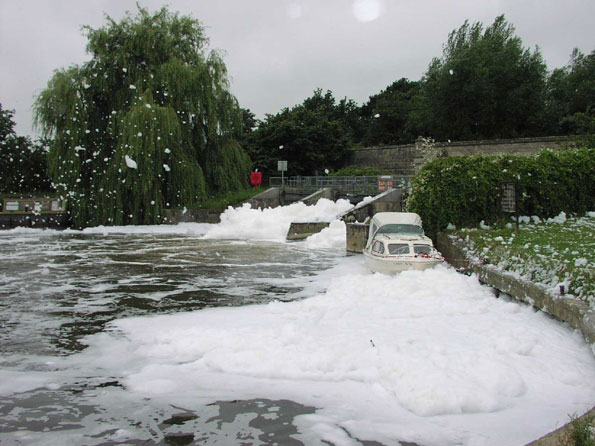Officers from the Environment Agency are investigating a foam spillage that is travelling down the River Thames.
Environment Agency Lock Keeper Peter Payne reported up to six feet of foam as it went through Lechlade weir last night (Thursday) and further foaming has occurred at Buscot, Radcot and Rushey locks.
The foam, which is fire-fighting foam, has killed fish along a 3km stretch of the Dudgrove Brook in Fairford, where the spillage was first reported. The foam can cause irritation to eyes and skin and should be avoided.
The Environment Agency was called to the brook yesterday morning after reports that foam had entered the surface water system.
Dead fish were found in the surface water interceptor and more than 1km downstream from where it discharges into the brook. The interceptor was blocked off to prevent further discharges, but the foam had coursed down the River Colne, where further dead fish were found.
The main effects of the foam on water quality will be to affect dissolved oxygen, but it is not expected to have a significant impact on the Thames because the foam has been well diluted and will disperse naturally over time.
Investigating officer Emma Bateman said: “We are keeping a close eye on the progress of the slug of foam down the Thames today, and we expect it to go through Oxford during the course of the day.
“It is not obvious to people while it travels along the main stretches of the water, but it may foam up naturally as it bubbles over the weir, and it can look quite impressive.
“We have received reports that people have suffered from sore throats and itchy eyes if they are near the foam, and if members of the public experience these symptoms they should seek medical advice.”
“Fisheries officers are also assessing the impact of the foam on local wildlife and we will continue to do so. We won’t know exact figures of fish killed until the site has been cleared up properly. However, it will be some time before we know the full environmental impact of the pollution.”
The Environment Agency believes it has traced the source of the pollution and the investigation is ongoing. No further details can be released at this stage.
Members of the public can report pollution incidents by calling the Environment Agency’s emergency hotline on 0800 807060.







